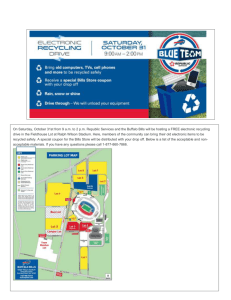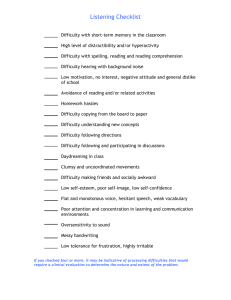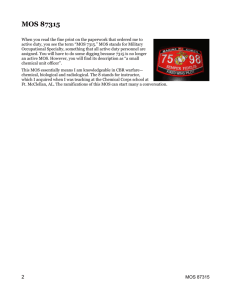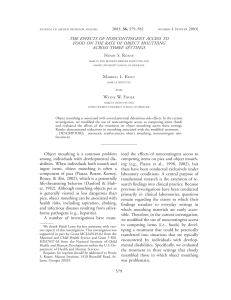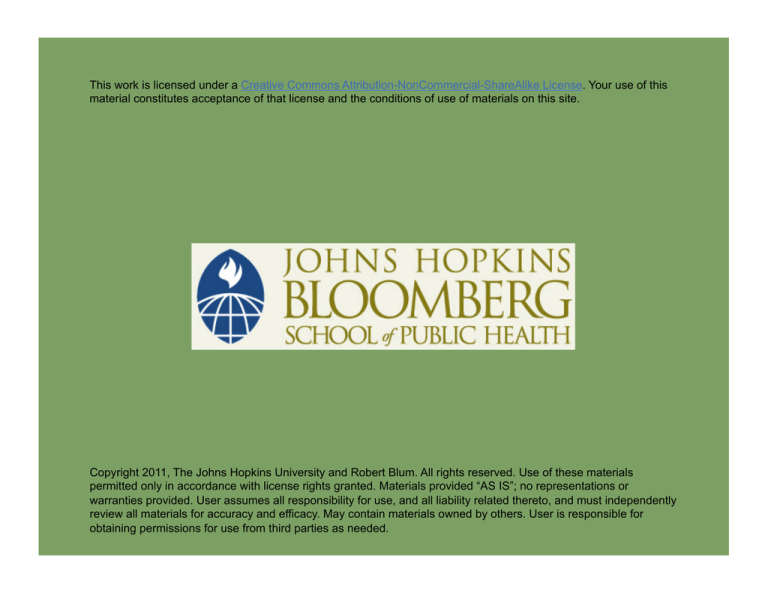
This work is licensed under a Creative Commons Attribution-NonCommercial-ShareAlike License. Your use of this
material constitutes acceptance of that license and the conditions of use of materials on this site.
Copyright 2011, The Johns Hopkins University and Robert Blum. All rights reserved. Use of these materials
permitted only in accordance with license rights granted. Materials provided “AS IS”; no representations or
warranties provided. User assumes all responsibility for use, and all liability related thereto, and must independently
review all materials for accuracy and efficacy. May contain materials owned by others. User is responsible for
obtaining permissions for use from third parties as needed.
Section B
Physical Environments and Toxic Exposures
A Child’s Changing Environments
Age
Behaviors related to
exposure
Physical spaces
0–2 mos.
Breast/bottle fed; hand to
mouth, surface contact
Breathing space close to
floor; sedentary, home/
daycare
3–11 mos.
Floor mobility increases;
mouthing objects; food
consumption
Floor; mobility may stir dust
particles
12–23 mos.
Consumes all foods, highly
mobile, touching and
mouthing
Upright, wider breathing
zones, more out-of-home
exploration
2–5 years
Hand to mouth declines
Outdoor spaces increase
6–10 years
Decreased tactile and oral
exploration
School, sports, and social
environments
Source: Based on Moya et al. (2004). Pediatrics.
3
Portals of Entry and Exposures
Portal of entry
Exposures
Breast milk
PCB, dioxin
Food
High dairy and fruit intake: Alar, PCB,
organophosphates
Drinking water
Fertilizers, pesticides, mercury
Soil
Pica: lead, fertilizers, pesticides
Inhalation
Mites, dust, allergens, nicotine
Skin
Organophosphates, lead, toluene, nicotine
4
Toxins and Their Consequences
Toxin
Consequences
Lead
IQ deficit, hyperactivity, attention problems, LD,
violence/aggression
Mercury
Visual impairments, LD, attention deficit, motor
dysfunction
Ethanol
Memory impairments, LD, attention deficits,
behavior problems, craniofacial/limb/cardiac
abnormalities
Toluene
Craniofacial abnormalities, speech deficits, motor
dysfunction, LD
Organophosphates
Developmental delays, hyperactivity, inability to
draw familiar objects, decreased memory, decreased
stamina
Nicotine
Hyperactivity, LD, delay in cognitive development
Dioxins/PCB
LD, memory impairment, hyperactivity
5
Conditions That Negatively Affect Brain Development
Alcohol
Lead
Tobacco
Prenatal infections (TORCH)
Ionizing radiation
6
Conditions That Negatively Affect Brain Development
Alcohol
Lead
Tobacco
Prenatal infections (TORCH)
Ionizing radiation
Cocaine
Metabolic disorders (PKU)
Mercury
Iron deficiency
Chronic stress
7

